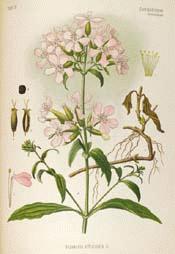

|
Soapwort
(Saponaria officinalis LINN.)
|
Soapwort
Botanical: Saponaria officinalis (LINN.)
Family: N.O. Caryophyllaceae
---Synonyms---Soaproot. Bouncing Bet. Latherwort. Fuller's Herb. Bruisewort. Crow Soap. Sweet Betty. Wild Sweet William.
---Parts Used---Dried root and leaves.
---Habitat---Central and Southern Europe. Grows well in English gardens.
---Description---A stout herbaceous perennial with a stem growing in the writer's garden to 4 or 5 feet high. Leaves lanceolate, slightly elliptical, acute, smooth, 2 or 3 inches long and 1/3 inch wide. Large pink flowers, often double in paniculate fascicles; calyx cylindrical, slightly downy; five petals, unguiculate; top of petals linear, ten stamens, two styles; capsule oblong, one-celled, flowering from July till September. No odour, with a bitter and slightly sweet taste, followed by a persistent pungency and a numbing sensation in the mouth.
---Constituents---Constituents of the root, Saponin, also extractive, resin, gum, woody fibre, mucilage, etc.
Soapwort root dried in commerce is found in pieces 10 and 12 inches long, 1/12 inch thick, cylindrical, longitudinally wrinkled, outside light brown, inside whitish with a thick bark. Contains number of small white crystals and a pale yellow wood.
---Medicinal Action and Uses---A decoction cures the itch. Has proved very useful in jaundice and other visceral obstructions. For old venereal complaints it is a good cure specially where mercury has failed. It is a tonic, diaphoretic and alterative, a valuable remedy for rheumatism or cutaneous troubles resulting from any form of syphilis. It is also sternutatory. Should be very cautiously used owing to its saponin content.
Dose. - Decoction, 2 to 4 fluid ounces three or four times daily. Extract or the inspissated juice will be found equally efficacious: dose, 10 to 20 grains. As a sternutatory 2 to 6 grains. Fluid extract, 1/4 to 1 drachm.
[Top]
Common Name Index
A MODERN HERBAL Home Page
Purchase this Herb from Botanical.com
Bear in mind "A Modern Herbal" was written with the conventional wisdom of the early 1900's. This should be taken into account as some of the information may now be considered inaccurate, or not in accordance with modern medicine.
© Copyright Protected 1995-2004 botanical.com

|

